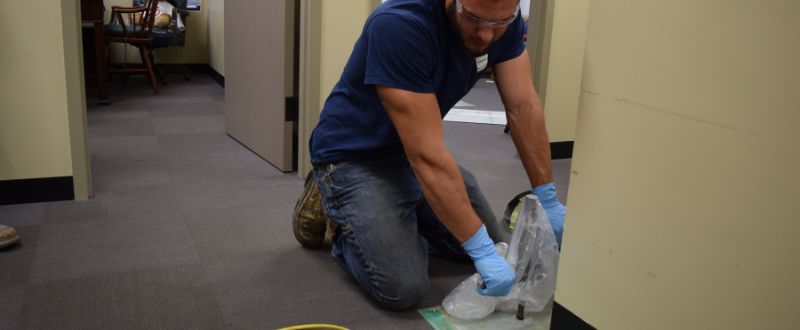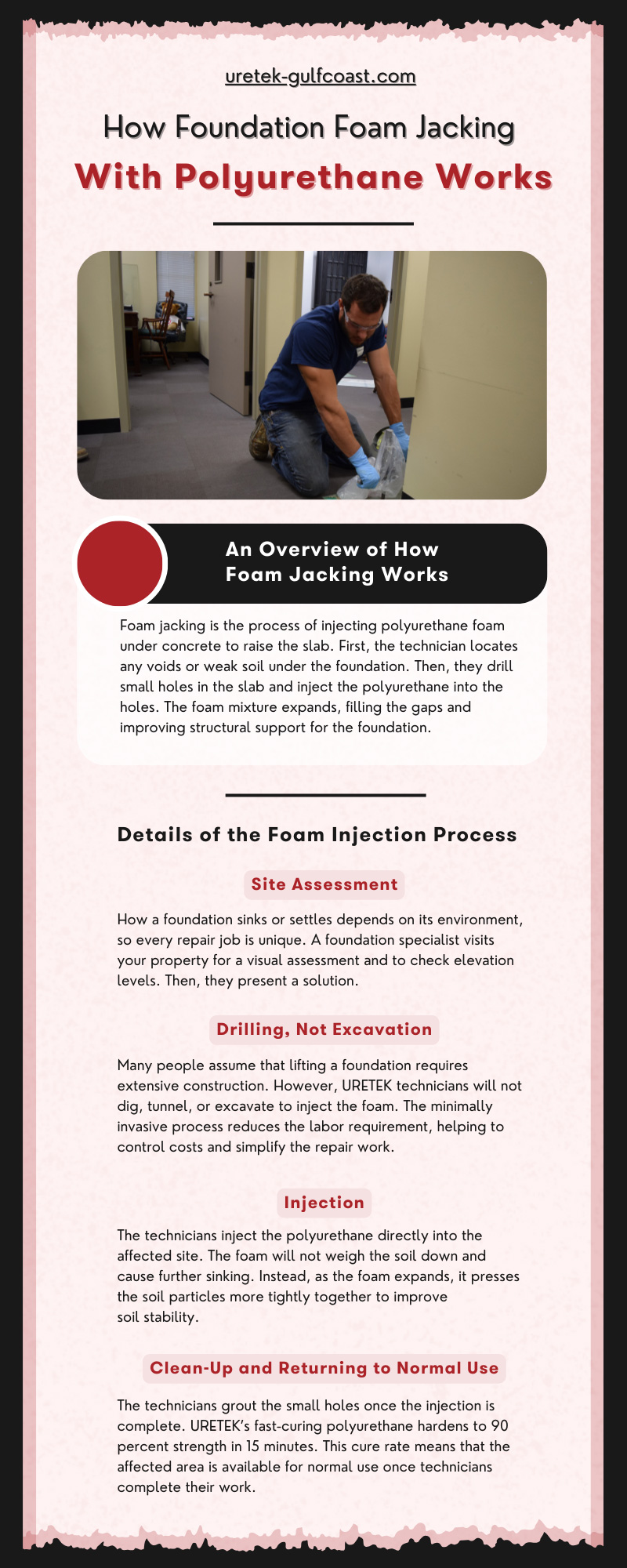Your property’s concrete slab foundation supports the entire building, helping to keep the floors even and the walls aligned. The foundation also resists ground movement that might otherwise cause your home or business to break apart.
Over time, foundations show the stress of acting as a protective barrier and support. Cracks, sinking, and settling can threaten the foundation’s integrity. Learn how foundation foam jacking with polyurethane works to address foundation issues.
Understanding Foundation Sinking and Settling
Foam jacking addresses sinking and settling, two common problems property owners encounter with their concrete slabs. Sinking foundations continue to move downward, while settled foundations have lowered into a fixed position.
Soil Conditions Cause Sinking and Settling
Changes in the soil under the concrete cause the slab to move. Varying moisture levels make the ground expand or shrink, changing the foundation’s position.
Soil can also get washed away over time due to natural or extreme weather events, and running water can move dirt around and create air pockets called voids in the earth. Soil shrinkage can also create gaps in the soil.
Without properly compacted soil, the concrete slab cannot lie securely. The foundation then sinks or settles, causing uneven floors, misaligned frames, and cracks on interior and exterior walls.
An Overview of How Foam Jacking Works
Foam jacking is the process of injecting polyurethane foam under concrete to raise the slab. First, the technician locates any voids or weak soil under the foundation.
Then, they drill small holes in the slab and inject the polyurethane into the holes. The foam mixture expands, filling the gaps and improving structural support for the foundation.
Foam jacking can also be called poly jacking or poly leveling. Foam jacking foundation repair is a straightforward and effective way to make long-lasting repairs to sinking or settled slabs.
Understanding the Benefits of Polyurethane Foam
Polyurethane foam is strong, lightweight, and dense. These characteristics make it a superior material for filling soil voids and supporting concrete slabs.
This foam is exceptionally durable. Over time, it retains its strength and structure, reducing the likelihood of new gaps forming or further concrete settlement.
The following are key benefits of polyurethane foam jacking:
- Cost-effective
- Minimally invasive
- Quick process
- Long-lasting results
- Environmentally inert
Foam Jacking vs. Mudjacking
Mudjacking is another foundation repair method similar to foam jacking, but it uses a heavy water-based slurry that contains a mixture of soil or clay, small amounts of cement, and other materials. Because the mudjacking material is not lightweight, it compresses the soil underneath it.
Over time, the weight of the mudjacking material may cause the foundation to sink again. Polyurethane foam does not have this effect because it does not add immense weight to the soil. Instead, the foam compresses the soil particles together through expansion.
Major Differences Between URETEK’s Patented Foam and Others
The difference in quality between mudjacking material and polyurethane foam is undeniable. In addition, it’s important to note that different types of polyurethane foam exist.
URETEK ICR Gulf Coast uses a unique, patented foam to lift and stabilize slabs. Our foam is structural grade, hydro-insensitive, and environmentally inert.
Structural Grade
Our foam is closed cell, meaning it has cells completely closed off from air and moisture. The closed cells make the foam more dense and rigid, providing superior stability over other foams.
Hydro-Insensitive
Our polyurethane is hydro-insensitive, meaning it is unaffected by water. Despite the presence of water in the soil, the foam will expand as designed to fill voids and compact the soil. The material will maintain its strength and rigidity.
Environmentally Inert
Our patented foam will not promote changes to the soil. Independent laboratories have extensively tested the foam and found it environmentally benign with excellent chemical resistance.
The NSF/ANSI 61 standard is an American National Standard that establishes minimum health effects requirements for chemical contaminants indirectly imparted to drinking water. Our foam is NSF/ANSI 61 certified and safe in potable water.
Details of the Foam Injection Process
Now that you know the characteristics of polyurethane foam, consider the details of how foundation foam jacking with polyurethane works.
Using a superior product streamlines the injection process. Our foundation specialists have extensive experience, and we regularly retrain our technicians to ensure quality service.
Site Assessment
How a foundation sinks or settles depends on its environment, so every repair job is unique. A foundation specialist visits your property for a visual assessment and to check elevation levels. Then, they present a solution.
Drilling, Not Excavation
Many people assume that lifting a foundation requires extensive construction. However, URETEK technicians will not dig, tunnel, or excavate to inject the foam. The minimally invasive process reduces the labor requirement, helping to control costs and simplify the repair work.
Instead, technicians drill small holes of 5/8-inch diameter. The openings are placed under carpet or into grout lines when possible, leaving minimal traces.
Injection
The technicians inject the polyurethane directly into the affected site. The foam will not weigh the soil down and cause further sinking. Instead, as the foam expands, it presses the soil particles more tightly together to improve soil stability.
Precision control helps avoid the problem of overlifting the slab. The material expands predictably and moves smoothly, making it easier to monitor pressure dials to ensure level lifting.
Clean-Up and Returning to Normal Use
The technicians grout the small holes once the injection is complete. URETEK’s fast-curing polyurethane hardens to 90 percent strength in 15 minutes. This cure rate means that the affected area is available for normal use once technicians complete their work.
Avoiding Foundation Sinking and Settling Problems
Foundation sinking and settling can cause problems throughout the affected building. Over time, the issues can worsen. If you notice any of the following problems, foam jacking may be the right solution.
Sinking can make it difficult to close doors and windows. The building’s movement can pull and push door and window frames, creating imperfect closures.
Delaying repairs can lead to extensive property damage. Foam jacking foundation repair is a straightforward, cost-effective, long-lasting, and minimally invasive solution.
Most repair jobs can be completed within a day, protecting your home or business and giving you peace of mind. Contact URETEK ICR Gulf Coast today for a free estimate for your concrete slab.


